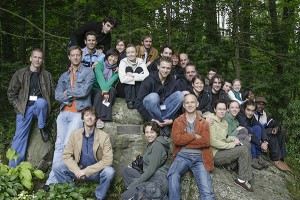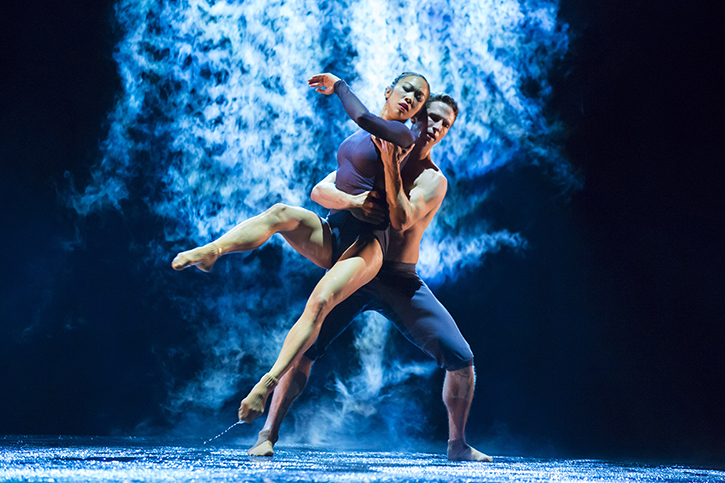Student Spotlight: Embedded with Hubbard Street Dance Chicago
Editor’s note: As part of the UMS 21st Century Artist Internships program, four students interned for a minimum of five weeks with a dance, theater, or music ensemble part of our 2015-2016 season. Meri Bobber is one of these students. This summer, she was embedded with Hubbard Street Dance Chicago.
Below, Meri shares her travel stories with the company in advance of their return Ann Arbor on October 27, 2015.
Assume nothing; be curious. This approach to artistry is something I learned from choreographer William Forsythe at Hubbard Street Dance Chicago’s Spotlight Ball on June 1, 2015. The glamorous night was a celebration of dance and highlighted the success and impact of Forsythe’s work, as the main company prepared to perform his choreography in its upcoming season. By the night of the gala, I was already a few weeks into my internship, but I carried this advice with me as I continued my summer in Chicago as a UMS 21st Century Artist Intern.
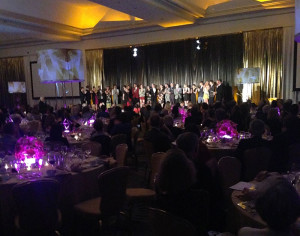

On left, the gala was held in a ballroom of the Fairmont Hotel in downtown Chicago. In this shot, dinner guests applaud as Artistic Director Glenn Edgerton introduces all the professional dancers of Hubbard Street. On right, Hubbard Street’s second company, comprised of early-career artists, perform a movement composition exercise to supplement the dance education of Chicago elementary school students.
My internship at Hubbard Street was structured so that I would rotate departments weekly for two months. This structure ultimately proved to be incredibly appropriate, as I saw firsthand that non-profit organizations require their employees to wear many hats, big and small, simultaneously, and to still maintain the ambition to learn on the fly, to jump in wherever he or she is needed. For example, the accounting manager at Hubbard Street also serves as IT. A former professional dancer of the company is now its Manager of Communication on the marketing team. When I joined the second company for a day of several dance outreach performances at Chicago area schools, the artistic director drove our van.
I practiced the same adaptability in my internship, beginning in artistic administration, where I was trusted with an important, ongoing project right away. One of the repetiteurs from The Forsythe Company was to come to Chicago and set three of William Forysthe’s works on the dancers for the performance Hubbard Street will bring to Ann Arbor in October. As an artist of German citizenship, he needed a visa for his work in Chicago. So, although I bounced around departments, I worked throughout my internship to research this repetiteur’s career, assemble resources, and write a coherent paper about him that proved the legitimacy of his trip and his work at Hubbard Street. I needed to present enough evidence to prove that he was the best and only man for the job. My supervisor worked closely with me on the project, taught me how to address the guidelines required by the government, and left me confident with a new, important skill. One of my highlights from the summer was the day that my supervisor informed me that the application had been accepted by the government. I met him in person later on, and his gratitude for my help with his application touched me. The work I had put into it proved successful for Hubbard Street and the Forsythe production.
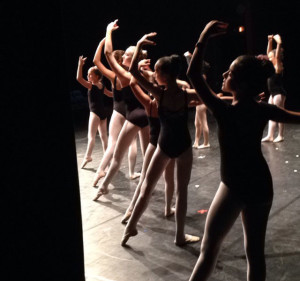
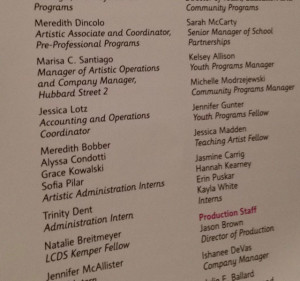
On left, a shot from backstage of the Hubbard Street Youth Showcase where I helped the professional dancers of tomorrow make it on stage in time for their numbers. On right, I spent the week leading up to Hubbard Street’s Summer Series at the Harris Theater helping out at dress rehearsals backstage. It was a treat to find my name included on the Hubbard Street Staff listing in the program on opening night!
I switched responsibilities each Monday. I served in the marketing department, where I initially felt far out of my comfort zone but ultimately learned a lot in just five days; the youth education department, where I made great friends with other interns and helped the youth showcase recital run smoothly; backstage of the Harris Theater downtown, where I assisted Hubbard Street’s main company manager during a production that featured the work of resident choreographer Alejandro Cerrudo; and the development department, where I learned about external affairs and donor profiling, and helped out behind the scenes at the aforementioned gala. And that’s just to list a few!
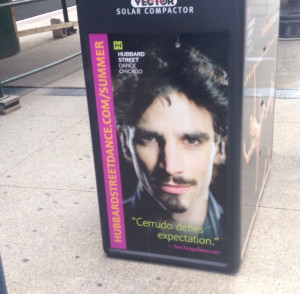

On left, Hubbard Street marketed the Summer Series show with ads like this all over street kiosks downtown. It was fun to learn about such marketing strategies at work, then go see them in action on my walks to and from the theater. On right, Hubbard Street’s Resident Choreographer Alejandro Cerrudo signed my program on closing night of the Summer Series.
Following the internship, I stayed on for a third month to participate in the college-level summer dance intensive. This is a program I enjoyed thoroughly last summer as well. I was happy to have Hubbard Street’s artistic staff, alumni, and current dancers give me another satisfying amount of choreography to study and a technical kick-in-the-pants. The training tested my adaptability as a dance artist, connected me with talented young dancers from around the country, and filled gaps in my technique. It was a special experience to come to the building every day and spend 8 hours in the studios just as Hubbard Street’s professional dancers do. I studied ballet, yoga, Pilates, improvisation, Gaga technique, Horton technique, partnering, and a variety of diverse repertory excerpts that required me to dance with different qualities and intentions. I sweat. A lot.
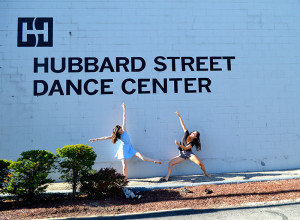

On left, one of my closest friends from school, Lena Oren, came into Chicago for the summer intensive. Here we are dancing outside of Hubbard Street’s building, located on Jackson Boulevard and Racine Avenue. On right, the summer intensive concluded with an in-studio showcase, which offered my fellow dancers and me the opportunity to perform the repertory excerpts we had been studying for the past four weeks.
Beyond working and dancing at Hubbard Street’s building in the West Loop, I found that living in Chicago in the summertime was delightful. I grew up in Milwaukee, but hanging out on Lake Michigan’s lakefront never gets old. The Brown Line to Kimball route of the Chicago Transit System (the “L,” as locals call it) offers stunning views of the downtown Loop. The Taste of Chicago food festival, the Bean, Buckingham Fountain, and the city’s diverse and characteristic neighborhoods gave me much to do and explore. I had the priceless company of my older sister, who has lived in Chicago for more than a year now, and my best friend from school, who traveled from California to participate in the summer intensive at Hubbard Street with me. We ate out, walked the lakefront, hung around Clark Street, and attended street festivals, parades, and shows. I also used my weekends to attend dance classes and shows anywhere and everywhere in an attempt to acquaint myself with Chicago’s greater dance community.
I subleased two apartments during my three months there: one from a coworker at Hubbard Street, a 15-minute walk from the West Loop (where Hubbard Street’s building is located) in the quaint, historic Little Italy neighborhood of Chicago. The other sublet was more of a gamble. I lived with a stranger far uptown at Lawrence and Clark, a location that required me to learn how to navigate Chicago’s public transportation system each morning in order to get to work. In terms of my mysterious roommate, I actually got very lucky. I lived with a Chicago and dance enthusiast who showed me around the city, specifically the characteristic area of Lincoln Square, and has become one of my closest friends.
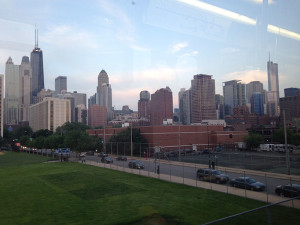
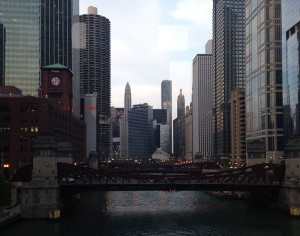
On left, Chicago skyline from the Brown Line train north to Kimball. On right, downtown loop of Chicago from the Brown Line train north to Kimball.
And so, both inside and outside of Hubbard Street’s building, my summer in Chicago fulfilled and excited me day-by-day. The pressure of having new assignments and needing to catch on to the operations of a new department at Hubbard Street every week honestly made me a little anxious on Monday mornings (especially during my week in marketing, an area in which I had no previous experience). The variety of choreography I studied during the intensive also required me to be flexible, in more ways than one! So I learned to adapt to the diversity in both the office and the studio, and to do my best with all that was thrown my way.
My to-do list throughout those three months was anything but monotonous. Every morning when I arrived at the building, I knew I could be asked to do just about anything to help make dance happen. I rolled out a marley floor. I organized video archives. I sifted through the dusty costume cage in the back warehouse. I wrote and I researched. I faxed and I answered phones. I brainstormed and I went to meetings. I ordered and picked up gifts for the choreographer on opening night. I ran the video camera at technical and dress rehearsals. I went to dance class and came back day after day with more sore spots and bruises. I cared to finesse the individual details and qualities of each piece I was taught. I tried assuming nothing and being curious all summer long, and it was an impactful approach to my working to bridge my student experience with becoming a professional.
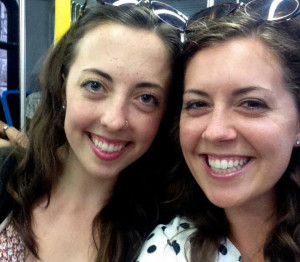
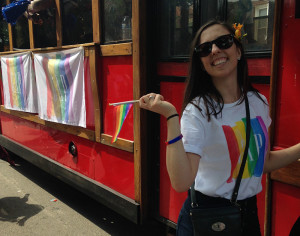
On left, my Chicago-based older sister and I on a city bus. On right, Here I am at the Chicago Pride Fest, one of the many summer city activities I soaked up. Others included Taste of Chicago, the Blackhawks Stanley Cup Victory Parade, and free concerts at the outdoor Jay Pritzker Pavilion.
I left Chicago with a big-picture understanding of the many factors that make up the dance powerhouse that is Hubbard Street Dance Chicago. The organization offers more than 70 classes a week to the public, rents studio space out to dance projects and companies, holds special dance education workshops through The Parkinson’s Project and The Autism Project, educates young dancers in a variety of dance styles, practices dance outreach in Chicago’s public schools, develops early career artists through the second company, and produces professional shows that feature a wide range of choreography on national and international stages.
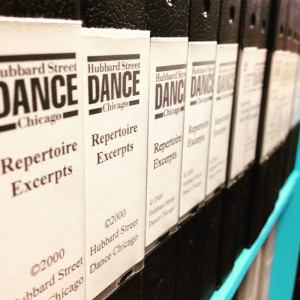
I spent one afternoon getting lost in Hubbard Street’s media room, which contains rehearsal and performance footage that dates back to the 1980s.
I now have a personal understanding of the effort, talent, teamwork, and dedication it takes to maintain such an umbrella for dance. The company dancers themselves are no less exceptional. They are thoughtful, articulate, versatile movers who appear almost invincible in the studio and in performance. When they grace the stage of the Power Center this October, you’ll see what I mean.
Hubbard Street Dance Chicago returns to Power Center with an evening of works by choreographer William Forsythe on October 27, 2015.
Interested in more? UMS Artist Services Manager Anne Grove was once company manager of Hubbard Street Dance Chicago. Read our interview with Anne.
Our artist services Manager Anne Grove with Hubbard Street Dance Chicago
Our artist services manager Anne Grove was once company manager with Hubbard Street Dance Chicago (who perform at Power Center September 27-28, 2013). Read our interview with Anne.
Outside Looking In: Anne Grove on Hubbard Street Dance
Editor’s note: Hubbard Street Dance Chicago return to Ann Arbor on October 27, 2015.
This UMS 13-14 Season, Hubbard Street Dance Chicago will be bringing their first, evening-length piece to Ann Arbor’s Power Center September 27-28. To learn more about Hubbard Street behind the scenes, their new work, and Hubbard Street’s first resident choreographer, Alejandro Cerrudo, I sat down with UMS Artist Services Manager, Anne Grove, to talk about her experiences working as the company manager of Hubbard Street prior to coming to UMS.
This is the first time Hubbard Street has performed with UMS while you are working at UMS. What does it feel like to have Hubbard Street perform as part of the UMS season?
I’m really proud to see the company coming here, bringing Alejandro’s work, and I’m excited to see them! I don’t get to Chicago very often, so I’m really looking forward to having them here and to fulfill my old role a bit, working with them backstage.
What was your favorite or most memorable experience while working with Hubbard Street?
There were so many it’s hard to land on one! For one thing, it was amazing to see what ambassadors the Hubbard Street dancers are for the city of Chicago and for dance. I’ve had so many people come up to me and say after seeing a performance, “Oh I’ve never really liked dance” or “never been interested in it,” but because Hubbard offered such a variety within a single performance, it was a really great entry point into dance for a lot of people.
Personally, I really enjoyed the places I was able to travel to during my time as Company Manager. The events and receptions I attended, the people I was able to meet because I was a part of Hubbard Street that I never would have had any chance to otherwise. In Paris, a woman who happened to really like dance hosted a reception for us in her apartment where there were original Picasso sketches just lying on the floor…it was like being in a movie. Getting to travel with these talented artists and taking care of them; it was an incredible experience.
Did you always know you wanted to work with Hubbard Street?
No. I first saw Hubbard Street many years ago when I was still in Minneapolis and working with a couple different theater companies when Hubbard Street came through on a tour. I met Gail Kalver several years later, executive director of Hubbard at the time, at a booking conference. I had been with the company for several years at that point and had always wanted to travel overseas. My position at that time with the theater didn’t allow for much travel. I was always the point person who stayed home. When the company manager position became available at Hubbard, I pursued that.
How prepared were you for your new position with Hubbard Street Dance, coming from theater?
I really didn’t know much about dance at all. For the first couple of years with Hubbard, I made lots of mistakes. Things that are very important to theater artists are not necessarily important to dancers. Something so easy as, when you’re traveling overseas, ensuring the hotels have bathtubs because all the dancers like to soak after performing. For the first European tour, I had no idea that was a priority. There was a big learning curve, but the dancers really helped me along.
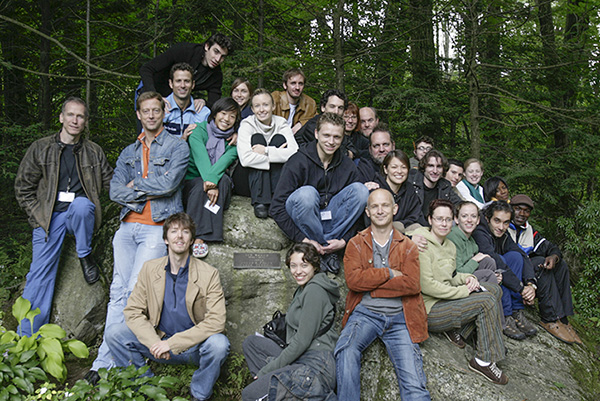
HSDC company photo on the Pillow Rock at Jacob’s Pillow Dance Festival, Becket, MA. Summer 2007. Alejandro (top) and Anne (bottom right, fourth person from the right)
Photo Credit: Cheryl Mann Photography
Hubbard Street is performing a piece created by choreographer Alejandro Cerrudo, entitled One Thousand Pieces, inspired by Marc Chagall’s America Windows. This work is the first evening-length piece they’ve ever performed. How do you see performing an evening-length piece as different from the vignettes they usually perform?
Well, as I alluded to before, the company is very much known for their repertory performances, so this is a really big step. With a repertory performance, you’re seeing work by lots of different choreographers, the pieces will be different, although you still try to program with something that brings the evening together or gives an arc to the performance as a whole. When you have a full-evening work, you’re still going to get some variety, but the performance will usually have just one central theme or look to it.
Has this been several years in the making?
Yes, they’ve been working towards this for a long time. I was with the company for 15 years and I think from my second or third year, they started talking about at some point doing a full evening work. There were many different choreographers discussed for doing a full evening work, and I’m so proud of the company for taking the big leap with Alejandro.
Not only is it the first evening-length work for Hubbard, but this was Alejandro’s first full evening work as well. Selecting such a young, up and coming choreographer really speaks to the core of what Hubbard Street is about: nurturing talented, young artists and helping them explore their talents.
Mr. Cerrudo was a dancer with the company before he became Hubbard’s first Resident Choreographer, yes?
Correct – he joined the company as a dancer in 2005 from NDT2 in Holland, although he is originally from Spain. NDT2 is legendary in its ability to identify and support the work of emerging professional choreographers. Alejandro participated in the choreographic workshops there and then at Hubbard, once he started dancing with us.
The first year Alejandro participated in the choreographic workshop, he did this amazing, beautiful duet, and Jim Vincent, artistic director at the time, asked him to create a full piece that grew out of that duet, which was later to become Lickity Split. And then, every year, Alejandro created a piece in that choreographic workshop which usually in one form or another became part of the Hubbard Street rep. In 2008, he became a choreographic fellow at Hubbard, and the following year, became Hubbard’s first resident choreographer. He’s done many works now for Hubbard as well as being hired by other companies to create for them.
Because he was a dancer with the company, he has gotten to know the Hubbard Street dancers in a way he does not know dancers from the other companies. The intimacy he was able to create in One Thousand Pieces because of that really comes across.
How do you think Chagall’s widely-known America Windows will function within the choreography of One Thousand Pieces?
Well, I’ve talked to Alejandro about it, and I was actually able to see the piece last fall when it was performed in Chicago, and I think it’s really important for people to know that the Windows were a point of inspiration.
He’s not recreating the windows or trying to tell a story. What influenced him was the idea of windows, and how windows and reflections off of glass distort, enhance, frame.
Also too he’s added some technical aspects that work with his voice and vision, embracing the technological age he grew up in. At one point in the piece, the dancers dance in water on stage in front of a mist curtain. You get the visual power of that, the smoothness of movement through the water, the sounds of that…it’s really quite unique and special.
Anything else audiences should look out for when seeing One Thousand Pieces?
I would encourage audience members to look for the duets, trios, and other small groupings of the company. I still harken back to the talent Alejandro displayed in choreographing the duet in his first workshop at Hubbard Street. He creates stunning duets, especially using his knowledge of the dancers on a personal level, having performed with them before, to his advantage. The group stuff is also very beautiful, but there’s something extraordinary about his small groupings.
I hope too that audiences will remain open-minded to a full evening, single-choreographer work from Hubbard Street. There’s music they’ll recognize, Philip Glass, and it’s a moment to enjoy the beauty of bodies, lighting, and music. Take away from it your own experience. Alejandro would say himself the piece doesn’t have to mean the same thing to him that it means to you. That’s not what it’s about. It’s about sharing that moment of beauty and letting it be whatever it is to you.
Thanks, Anne!
For more information on Hubbard Street performing at UMS this fall, see their artist page [here].


